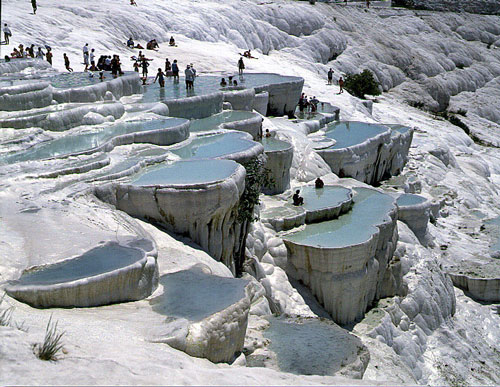What is Travertine? How is travertine formed?
What is Travertine? They are chemical sedimentary rocks formed by the expansion of carbonate and calcium. It consists of both chemical and physical movements in its content. They occur as a result of the realization of some permanent conditions of calcium and carbonates of natural water resources of under-ground mines. When these collapses are continuous, they cause the formation of travertines with soft lines and textures. The conditions that play a role in the formation of these natural events are the decrease in the amount of water, the carbon dioxide and evaporation in the water, and the decrease in the pressure above the water. It is a form of limestone that is more common on the hot spring side. It often has a fibrous concentric appearance.

The most common colors are tan, cream and white. It is mostly formed due to the precipitation of calcium carbonate in the mouth of the hot springs and limestone caves. Travertines are formed as a result of these natural events, as well as under-ground. If the precipitation process occurs slowly, the condensation in its composition becomes harder and more durable. If this precipitation process is fast, it is softer and brittle, and a sponge-like appearance is formed. Pamukkale travertines of Denizli, which are among the most beautiful travertine examples in the world. Travertine is among the structures used together with marble. In Turkey, travertine quarries of Denizli, Burdur, Burdur, Sivas, Mut, Mersin, Afyon regions are operated.
What are the Features of Travertines?
Travertines have physical properties such as surface finish, color and durability in their structure. Travertines have a soft hardness and are easy to remove due to this feature. Travertine is less dense than other marbles and is easier to transport. Another feature is the pores on the stone, giving it an old antique look. Beige and brown are among the most popular colors of travertines. Most travertines contain mixtures of white, dark brown and grey colors. Travertine does not heat easily, it is a little difficult for the heat to pass to this stone.

Since it stays cool, you can apply it outdoors with peace of mind. One of the main reasons why it is among the most preferred stone models in hot countries is that it does not pass the heat. It can sometimes be difficult to clean because travertines are perforated. It will be easier if it is cleaned with a vacuum cleaner, you can reach cheaper and reasonable prices compared to other stones. You can contact us for more information.
You can find Travertine Varieties here.
